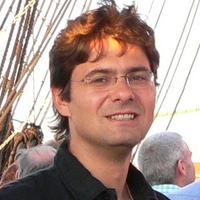Nikolaos Galiatsatos
Durham University, Geography, Faculty Member
- Durham University, Archaeology, Post-Docadd
- Spatial Modeling, Remote Sensing, Digital Photogrammetry applied to Archaeology, Multidisciplinary, Uncertainty Quantification, Research Data Management, and 7 morePhotogrammetry, Archaeology, Geography, Geographic Information Systems (GIS), Anthropology, Environmental Sustainability, and Landscape Archaeologyedit
Research Interests:
ABSTRACT We developed the technology of microslice integral field units some years ago as the next step in SAURON type microlens IFU design with typically 5 times more spatial elements (spaxels) for the same spectrograph and spectral... more
ABSTRACT We developed the technology of microslice integral field units some years ago as the next step in SAURON type microlens IFU design with typically 5 times more spatial elements (spaxels) for the same spectrograph and spectral length aiming at 1,000,000 spaxels IFUs. A full instrument for laboratory demonstration composed of the fore-optics, the IFU, the spectrograph and the detector has now been built and tested. It has about 10,000 spatial elements and spectra 150 pixel long. Our IFU has 5 cylindrical microlens arrays along the optical axis as opposed to one hexagonal array in the previous design. Instead of imaging pupils on the spectrograph input focal plane, our IFU images short slitlets 17 pixel long that keep the spatial information along the spatial direction then giving 17 spaxels per slitlet instead of one in pupil imaging. This removes most of the lost space between spectra leaving place for more and keeps the spatial information over the element size while pupil images lose it. The fore-optics re-images the field on the input of the IFU. They are made of cylindrical optics to get the desired different magnifications in both directions. All the optics and detector fit in a cylinder 35 mm in diameter and 280 mm long. With a different set of fore-optics on a 4-m telescope, a field of 43" x 6.7" with spatial elements of 0.14" x 0.22" could be observed so 12 of these mini-spectrographs would cover a field surface area of about 1 arcmin2 and 120,000 spaxels.
Research Interests:
Research Interests:
ABSTRACT: Remote sensing is a well established technique that has been employed in archaeological research for nearly a century. Until recently the technique was limited to site specific aerial photography focused solely in the visual and... more
ABSTRACT: Remote sensing is a well established technique that has been employed in archaeological research for nearly a century. Until recently the technique was limited to site specific aerial photography focused solely in the visual and near infra-red components of the electromagnetic spectrum. Improvements in sensor technology mean that archaeologists can exploit remotely sensed imagery from different electromagnetic wavelengths and platforms. This has the potential to increase the area of study and extend the window of ...
Research Interests:
Research Interests:
This paper aims to investigate the applicability of a relative radiometric normalisation method to a set of multitemporal images acquired by sensors of substantially different characteristics. The overall aim of the project is to assess... more
This paper aims to investigate the applicability of a relative radiometric normalisation method to a set of multitemporal images acquired by sensors of substantially different characteristics. The overall aim of the project is to assess the potential of satellite remote sensing for identifying forest land cover change in Scotland. In this study, the Pseudo-Invariant Features (PIFs) concept was investigated. PIFs
